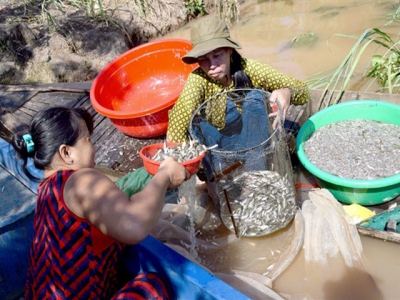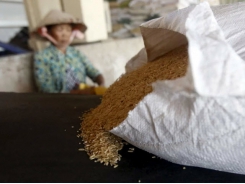Đồng Tháp to flood rice fields for fertility, flushing crop disease pathogens

ĐỒNG THÁP — The Cửu Long (Mekong Delta) province of Đồng Tháp plans to release floodwaters into 90,200ha of rice fields in this year’s rainy season to fertilise the soil and flush away rice disease pathogens.
Siamese mud carp and other small-sized fish are caught in the floodwaters in Hồng Ngự District’s Thường Thới Hậu A Commune in Đồng Tháp Province. — VNA/VNS Photo Chương Đài
The fields will be inundated up to 40-80cm until mid-October, according to the province’s Department of Agriculture and Rural Development.
The waters deposit sediments in fields.
This year, the flooding season began one month later than usual because of the low rainfall in the Mekong River’s upper reaches, and water began flowing into rice fields in upper areas in Đồng Tháp Province, one of the delta’s upstream provinces, only in early September.
Nguyễn Phước Thiện, deputy director of the department, said in areas with reliable dykes, localities could release floodwaters into rice fields but have to do so safely and ensure fruits orchards and vegetable fields are not affected.
They should proactively implement measures like inspecting and repairing important dykes protecting paddies, sluice gates and pumping stations to cope with floods and rains to protect crops, he said.
Nguyễn Văn Anh, a farmer in Hồng Ngự District’s Thường Thới Hậu B Commune, said: “Sediments make rice fields fertile and increase the rice yield in the next crop.”
But the floodwaters have inundated vegetables and short-term crops that were planted in alluvial areas along rivers.
Phạm Văn Đảo planted 1ha of papaya in Hồng Ngự District’s Thường Thới Tiền Town and it was inundated.
Locals thought the floods would not come this year and so planted short-term crops like red chilli and papaya, he explained.
The floods came when the crops fruited, and damaged them, he said.
Hồng Ngự District has 280ha of alluvial areas along the Tiền River, a tributary of the Mekong. Local authorities have warned farmers not to grow crops in the alluvial areas during the flood season.
But the floodwaters also bring fish and other aquatic species to provide a livelihood to many people.
The flooding season is also the harvest time for sesbania sesban and water lily flowers, specialty flood-season foods.
Đặng Văn Đức of Hồng Ngự District’s Thường Thới Hậu A Commune said he and his wife can catch a few kilogrammes of Siamese mud carp, a flood specialty, and dozens of kilogrammes of other small-sized fish every night.
They can earn VNĐ500,000-VNĐ1 million (US$21-43) a day from this, he said.
Traders buy Siamese mud carp for VNĐ80,000-100,000 a kilogramme and other small-sized fishes for VNĐ6,000.
The flooding in the upstream areas and rice fields this year is less than normal, according to the Đồng Tháp Centre for Hydro-Meteorology Forecasting.
It is expected to peak at the end of this month and early next month, it added.
Related news
Tools

Phối trộn thức ăn chăn nuôi

Pha dung dịch thủy canh

Định mức cho tôm ăn

Phối trộn phân bón NPK

Xác định tỷ lệ tôm sống

Chuyển đổi đơn vị phân bón

Xác định công suất sục khí

Chuyển đổi đơn vị tôm

Tính diện tích nhà kính

Tính thể tích ao



 Vietnamese pepper farmers struggle to survive
Vietnamese pepper farmers struggle to survive  Coffee export prices plummet
Coffee export prices plummet